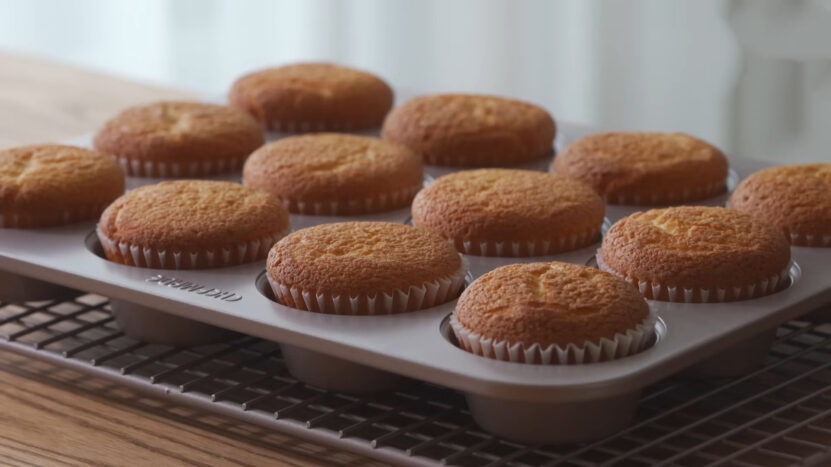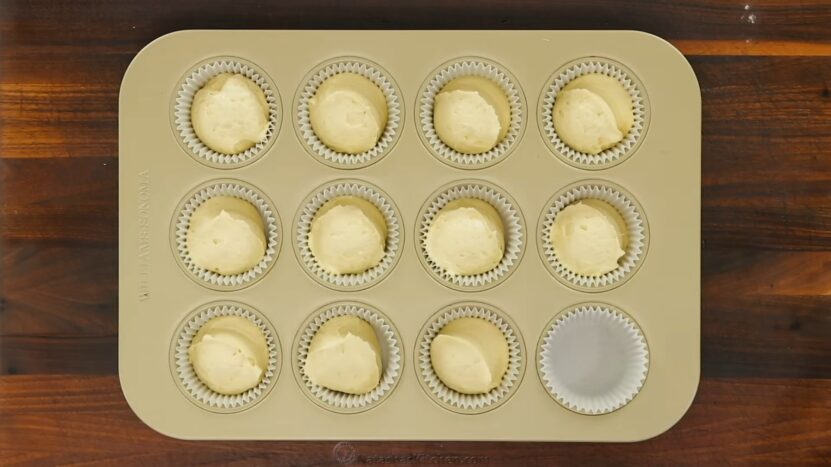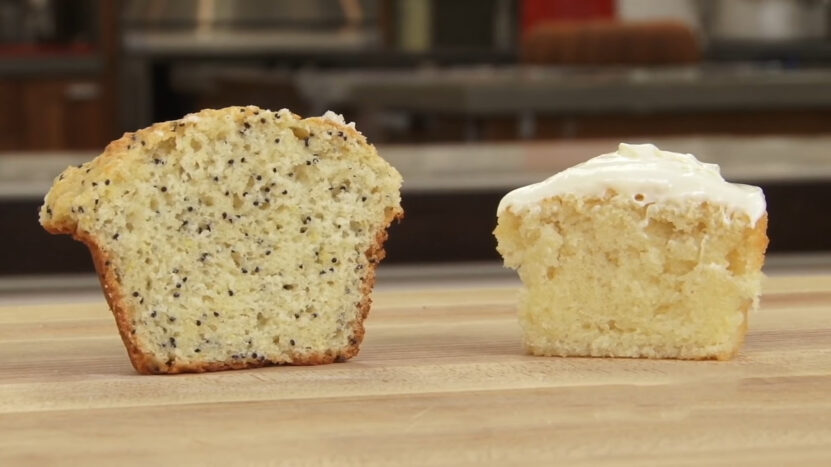Muffins and cupcakes: two delightfully familiar baked goods that often grace our breakfast tables and dessert menus. But what sets them apart?
At first glance, they seem quite similar, sharing a common shape and often baked in the same type of pan. However, dig deeper, and you will find a world of differences in their flavors, textures, preparation methods, and even nutritional profiles.
Today, I will discuss these differences, explaining what makes each treat unique.
Key takeaways:
- Distinct Preparation Methods: Cupcakes use the “cake mixing method” for a light, airy texture, while muffins employ the “muffin mixing method,” resulting in a denser, coarser crumb.
- Flavor and Ingredient Variation: Cupcakes are generally sweeter with higher sugar and fat content, often decorated with frosting. Muffins are less sweet, can include healthier ingredients like fruits, nuts, and whole grains, and may use substitutes like applesauce.
- Nutritional Differences: Cupcakes are indulgent treats high in sugar and fat, whereas muffins offer more nutritional flexibility and can be made healthier.
- Cultural and Historical Significance: Cupcakes have evolved into a symbol of celebration and are often used in events, while muffins have a more versatile role, suitable for breakfast or snacks.
- Adaptability in Baking: Both muffins and cupcakes allow for creative variations in flavor and composition, making them adaptable to different dietary preferences and occasions.
The Core Differences
Flavor and Texture
Cupcakes are, in essence, miniature cakes. They are characterized by their sweet flavor and soft, fluffy texture.
The “cake mixing method” used in their preparation ensures a fine, even crumb. This method involves creaming butter and sugar together before adding eggs, dry ingredients, and liquid alternately.
The result is a batter that’s light and airy, akin to traditional cakes. Muffins, on the other hand, are less sweet and offer a denser texture.
Their preparation employs the “muffin mixing method,” which involves mixing wet and dry ingredients separately before combining them. This method yields a batter with a coarser crumb and a more robust structure, suitable for incorporating fruits, nuts, and whole grains.
Muffins can also lean towards savory flavors, further distinguishing them from their sweeter counterparts.
Preparation Method
Cupcakes: Precision and Airiness
Cupcake batter demands precision. The ingredients must be balanced, and the mixing method is crucial to achieving the desired lightness.
Overmixing can lead to a tough texture, while undermixing may result in uneven baking.
Muffins: A Forgiving Mix
Muffin batter is more forgiving. The quick and gentle folding of ingredients, often leaving a lumpy batter, is key to maintaining the muffin’s characteristic texture.
This method also makes muffins a fantastic option for incorporating healthier ingredients like whole wheat flour, oats, and even substitutes like applesauce or mashed bananas.
Nutritional Content

Cupcakes
Cupcakes are high in sugar and fat, primarily due to their frosting and butter-rich batter. They are indulgent treats, often reserved for special occasions or as a dessert.
Muffins
While muffins can also be high in sugar, especially the commercially produced varieties, they offer more versatility in terms of health-conscious baking. Home bakers can reduce sugar content and include healthier ingredients like fruits, nuts, and whole grains, making them a more nutritious option for breakfast or snacks.
Decorative Aspects
Cupcakes are known for their decorative appeal. The use of frosting, fondant, and edible decorations allows for artistic expression, making cupcakes a popular choice for celebrations and themed events.
Muffins, in contrast, are usually devoid of elaborate decorations. They may have a simple glaze or a sprinkle of coarse sugar, but their appeal lies in their rustic simplicity and hearty texture.
Culinary Uses
Cupcakes are typically associated with parties, birthdays, and desserts. Their sweet nature and decorative look make them a festive choice.
Muffins are more versatile, suitable for breakfast, as a snack, or even as a side dish with savory variants. Their less sweet nature and denser texture make them a fitting companion to a cup of coffee or tea.
Healthier Baking Alternatives
While traditional muffins may contain less sugar than cupcakes, there is a growing trend in baking to make muffins even healthier. Bakers often substitute ingredients like white flour with whole wheat, oat flour, or almond meal.
Sweeteners like honey or maple syrup can replace refined sugar, and additions like flaxseeds or wheat germ boost nutritional value. These substitutions not only enhance the health profile of muffins but also add interesting textures and flavors.
In the realm of cupcakes, while they are inherently indulgent, there is room for moderation. Reduced-fat recipes, sugar substitutes, and smaller sizes can make cupcakes a less guilt-inducing treat.
Bakers can also experiment with adding pureed fruits or vegetables (like carrots or zucchini) to introduce moisture and slight nutritional benefits.
The Role of Frosting and Fillings
The frosting on cupcakes isn’t just for aesthetic appeal; it significantly impacts the overall flavor profile. Buttercream, cream cheese, or ganache, the choices are endless, each adding a different texture and sweetness level.
Some cupcakes even feature fillings, like jams or custards, adding a surprise element to each bite. Muffins generally steer clear of elaborate toppings.
A sprinkle of raw sugar, a handful of nuts, or a simple oat streusel can add a finishing touch without overpowering the muffin’s inherent flavors. This minimalist approach keeps the focus on the muffin itself, allowing the primary ingredients to shine.
Baking Techniques and Tips

Mastering Cupcake Baking
Achieving the perfect cupcake is about precision. Room temperature ingredients ensure a smoother batter, while careful measuring guards against imbalance in flavor or texture.
Timing is crucial—overbaking can lead to dry cupcakes.
Perfecting Muffin Recipes
With muffins, the key is not to overmix the batter. Lumps are perfectly acceptable and even desirable.
The baking temperature often starts high to create a burst of steam that lifts the muffin top, then reduces to cook through.
Serving and Consumption Trends
Cupcakes have become a versatile dessert option, suitable for formal events like weddings and casual gatherings alike. Their serving size makes them convenient and hygienic, a factor that has contributed to their popularity in recent times.
While traditionally considered a breakfast item, muffins have transcended this boundary. They’re now consumed throughout the day, as snacks or as part of a meal, reflecting the modern, on-the-go lifestyle where convenience and versatility are prized.
FAQs
Can muffins be made vegan more easily than cupcakes?
Yes, muffins can be made vegan more easily due to their denser texture and less reliance on eggs for leavening compared to cupcakes.
Is it possible to use a cupcake batter to make a cake?
Yes, a cupcake batter can be used to make a cake since it essentially follows the same ingredients and proportions as a cake batter.
Why do cupcakes rise more than muffins?
Cupcakes rise more due to the creaming method of mixing, which incorporates more air into the batter, unlike the more gentle mixing used for muffins.
Can I substitute oil for butter in muffin recipes?
Yes, you can substitute oil for butter in muffin recipes. This often makes the muffins moist and helps retain freshness longer.
Are there any savory versions of cupcakes, like savory muffins?
While less common, savory cupcakes do exist, often using ingredients like cheese, bacon, or herbs, they are not as prevalent as savory muffins.
Can I freeze muffins and cupcakes for later use?
Yes, both muffins and cupcakes can be frozen. However, it’s best to freeze cupcakes without frosting and add it after thawing.
Final Words
Both muffins and cupcakes have their unique place in the world of baking. Knowing their differences not only enhances our appreciation of these treats but also guides us in creating the perfect batch, whether it’s a fluffy cupcake for a birthday party or a hearty muffin for a morning start.
